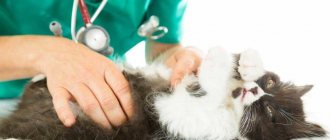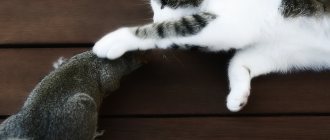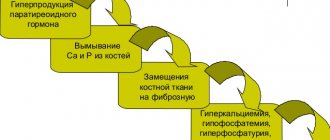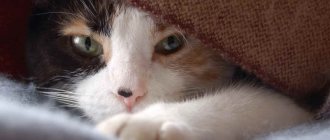One of the most common diseases of the digestive system among cats is cholecystitis. The causative agents of this disease are various microbes, including streptococci, Escherichia coli, etc.
Leading veterinarians at the clinic talk about what this disease is, how it progresses and what the main features of treatment are.
Read in this article
What is this? Causes of the disease Symptoms of cholecystitis in a cat: what to look for? Forms of cholecystitis: acute and chronic First aid for cholecystitis Methods for diagnosing the disease How and with what to treat cholecystitis in cats? What to feed a cat with cholecystitis? Effective recommendations for disease prevention
Causes of the disease
Cholecystitis in cats can be caused by various reasons. The most common is cholelithiasis (GSD). As for provoking factors, these include the pet’s sedentary lifestyle, age and impaired gallbladder tone.
The main causes of cholecystitis in cats:
- Poor nutrition. Cheap mass-market food, expired products and a lack of vitamins (especially vitamin B1) provoke the development of inflammatory processes. Pathogenic microorganisms penetrate the gallbladder and cause inflammation.
- Invasive diseases (helminths). A common cause of helminth infection is feeding your pet raw fish or meat. Parasites clog the bile ducts and penetrate the gallbladder, which leads to disruption of its functions.
- Blockage of the bile ducts. The main reasons that can lead to this condition: cholelithiasis (GSD), pancreatic tumor, etc. All this provokes the development of an acute inflammatory process.
- Infectious diseases . Both bacterial and viral infections can lead to gallbladder inflammation. Among the most dangerous diseases leading to cholecystitis: leptospirosis, viral hepatitis, “feline distemper”, etc.
- Damage or rupture of the gallbladder. It occurs when there is a serious mechanical injury: a cat falling from a great height, strong impacts, collisions, etc. Chronic inflammation can also lead to perforation (breaking through) the walls of the gallbladder.
Diet and nutrition
In the first two days of exacerbation of cholecystitis, only warm drinks are allowed (sweet weak teas, fruit and vegetable juices diluted with water, still mineral water). You need to drink one and a half liters in small doses during the day. A few crackers are allowed. As the intensity of pain decreases and the general condition improves, the diet is expanded.
Diet for cholecystitis
Recommended for use:
- pureed vegetable soups with cereals;
- porridge (buckwheat, oatmeal, semolina, rice);
- various mousses, jelly, jellies;
- low-fat cottage cheese;
- boiled fish (low-fat);
- boiled pureed meat (rabbit, turkey, chicken or veal);
- steamed cutlets;
- white bread croutons.
During an exacerbation, it is necessary to arrange a fasting day once a week:
- kefir-curd day: 900 grams of kefir in six doses; 300 grams of low-fat cottage cheese in three doses; 100 grams of sugar (during the day);
- compote-rice day: one and a half liters of compote from fresh (one and a half kilograms) or dried (240 grams) fruits in six doses; rice porridge with water (50 grams of rice in three portions).
This diet recommends:
- dairy, fruit and vegetable soups with noodles or cereals;
- boiled lean meat (rabbit, chicken, beef or turkey);
- steamed cutlets made from this meat (or meatballs);
- low-fat boiled or baked fish (river or sea) with mandatory removal of the crust;
- one (maximum two eggs) per day in the form of a steamed or soft-boiled omelet;
- low-fat milk;
- low-fat cottage cheese;
- kefir;
- curdled milk;
- yogurt;
- a small amount of butter;
- boiled or baked vegetables (some can be eaten raw):
- potato;
- carrot;
- beet;
- tomatoes;
- pumpkin;
- cucumbers;
- Bell pepper;
- cauliflower or Chinese cabbage;
- eggplant;
- zucchini;
berries and fruits:
- pear;
- melon;
- peach;
- banana;
- apricot;
- watermelon;
- apples (non-acidic varieties, preferably baked).
porridge (you can use it with milk, if there is no individual intolerance):
- buckwheat;
- oatmeal;
- semolina;
- rice.
sweets (limited):
- marmalade;
- paste;
- jam;
- honey;
- jelly;
- jam.
flour:
- rye and wheat yesterday's bread;
- white bread croutons;
- unpalatable and dry cookies.
Having breakfast is a must; dinner should be light, two to three hours before bedtime. The daily volume of fluid you drink is not limited.
In such cases, a large amount of food consumed at one time leads to a disruption in the rhythm of bile secretion, which causes a spasm of the gallbladder, and, consequently, pain.
Not recommended for use (especially after removal of the gallbladder):
- products containing large amounts of animal fats;
- fried foods;
- smoked meats;
- fatty sausages;
- fat meat;
- fatty fish;
- fatty bird (for example, duck);
- mayonnaise;
- cakes;
- cakes;
- ice cream;
- raw onion;
- radish;
- garlic;
- spinach;
- sorrel;
- mushrooms;
- legumes (beans, peas, etc.);
- cold drinks;
- carbonated drinks;
- concentrated types of juices;
- cocoa;
- coffee;
- alcohol (including beer).
Symptoms of cholecystitis in a cat: what to look for?
The first thing that indicates cholecystitis in your pet is nausea and vomiting containing bile. A sick cat refuses to eat and therefore rapidly loses weight. Due to the inflammatory process, she will experience increased body temperature and general weakness.
The main symptoms of cholecystitis in cats:
- nausea and vomiting,
- bloating of the abdominal area,
- increase in body temperature,
- lethargy and apathy,
- constipation,
- peeling of the mucous membranes of the oral cavity,
- yellowness of the sclera of the eyes.
In severe forms of cholecystitis, the cat experiences severe pain. She meows loudly, behaves aggressively, does not allow the abdominal area to be touched, etc. Fever may develop (for example, if cholecystitis is caused by an infectious disease).
The first signs of ill health
An animal's behavior always serves as a reliable indicator of its condition. Any oddities you notice will help your doctor diagnose cholestasis in cats: treatment will also depend on this
Pay attention to any behavior patterns that have appeared recently:
- unsociability or, conversely, increased activity;
- drowsiness;
- change in taste habits or lack of appetite;
- attacks of aggression in a usually calm animal.
It is important to detect cholestasis in cats in time: treatment, or rather its effectiveness, is directly related to the time factor. There are also obvious signs of the disease, if they appear, you should immediately consult a doctor or call a veterinarian at home:
There are also obvious signs of the disease, if they appear, you should immediately consult a doctor or call a veterinarian at home:
- spasm;
- vomit;
- change in body temperature;
- dry and hot nose;
- redness or dryness of mucous membranes.
Forms of cholecystitis: acute and chronic
Spicy . Often develops in cats against the background of cholelithiasis (GSD). The gradual accumulation of bile leads to infections and acute inflammation of the walls of the gallbladder. Acute cholecystitis develops rapidly - within a few days or even hours.
Chronic . It occurs as an independent disease, and the entire clinical picture develops gradually. Temporary improvements in the condition are possible. The main danger of chronic cholecystitis is the difficulty of timely diagnosis.
Prevention
To prevent the development of gallstone disease in cats, veterinarians from the Bars veterinary complex recommend monitoring your pets’ diet. You will need to remove excessive amounts of fish from the animal menu, replacing it with lean types of meat. The menu should be enriched with food that contains enough vitamins and microelements. It is recommended that cats eat fermented milk products in limited quantities; sometimes you can give them a little boiled potatoes and legumes. In addition, from time to time, animals should be given special vitamins for cats. An important and preventive measure is the drinking regime. There should always be water near the bowl of food. In this case, the liquid should not be poured from the tap; you should use purified liquid.
Methods for diagnosing the disease
If you suspect that your cat has cholecystitis, contact a veterinary clinic in Moscow immediately. The first thing a specialist will do is conduct a diagnosis. He will not be able to make an accurate diagnosis based on symptoms alone, so additional research will be required.
Appointed:
- general/biochemical blood test,
- ultrasound diagnostics,
- fine needle biopsy,
- scintigraphy (functional imaging) of the gallbladder,
- differential diagnosis.
With cholecystitis, the level of bilirubin (from 7.9 µm/l), alkaline phosphatase and cholesterol increases in a cat. When determining the diagnosis, the veterinarian also takes into account the level of bile acid and endogenous enzyme from the transferase group.
Diagnosis of gallbladder inflammation
The basis for diagnosing cholecystitis is the anamnesis collected by the therapist. During the initial examination, the doctor palpates the abdomen. While palpating the abdominal cavity, he asks about pain on the right side of the torso and determines the pinpoint muscle tension in the area of the organ being examined. Pain syndrome occurs when lightly tapping the area of the right hypochondrium.
During the examination of the patient, hepatic colic is excluded or confirmed. The presence of stones in the bile ducts and an increase in the size of the organ is diagnosed using an ultrasound machine. The ducts of the organ are examined in detail using endoscopic retrograde cholangiopancreatography.
At the point of mandatory tests: urine and blood, which show ESR, leukocyte content, bilirubin level, indicate the presence of dysproteinemia. Urine biochemistry reveals high activity of amylase and aminotransferases.
The doctor conducts a visual examination of the tongue, sclera of the eyes, and skin. If the integument is yellowish, this is a reason to be wary. If there are suspicious symptoms during the initial diagnosis, in-depth studies are carried out using methods such as:
- blood biochemistry (in the acute phase, the analysis will show a high volume of gamma-glutamyl transpeptidase, bilirubin, haptoglobin, CRP, alkaline phosphatase);
- hemogram (the disease is characterized by the presence of an inflammatory process, which is indicated by accelerated ESR, thrombocytosis, leukocytosis);
- clinical urine test (bile pigments are detected after an attack of pain);
- CT or MRI (non-contrast accurate studies of the abdominal cavity with high information content). Using such techniques, it is possible to determine the patency of the bile ducts and exclude a number of complications of the disease;
- ultrasonography allows you to assess the size of the diseased organ: determines the presence of stones, clarifies the condition of the mucous membrane and internal walls, checks the condition of the bile;
- endoscopic ultrasonography. The technique is a combination of ultrasonography and fibrogastroduodenoscopy (a microcamera is fixed on the endoscope). This method allows you to create an accurate picture of the bile ducts;
- duodenal sounding. Collection of a portion of bile, which is taken for examination. If the secretion contains flakes and protozoa, and the bile itself is cloudy, this is an alarming symptom;
- culture of the contents of the gallbladder. The analysis determines the presence and type of pathogenic microorganisms, tests for sensitivity to a number of antibacterial drugs;
- X-ray of the abdominal cavity (the method determines perforation of the diseased organ and indicates the presence of stones);
- contrast cholecystography (x-ray technique). It determines the presence of stones and identifies a “non-functioning” organ. During the study, contrast is administered into a vein or orally, through which stones and other functional disorders are detected. In recent years, this method has been used less frequently, since ultrasonography is a gentle but informative method;
- radioisotope cholescintigraphy with technetium determines the presence of inflammation;
- Retrograde cholangiopancreatography. Using a diagnostic method, blockage of the lumen of the ducts is detected and, if necessary, small formations are removed;
- radioisotope hepatocholecystography makes it possible to determine the type of functional disorder of the organ;
- molecular genetic and immunological analyzes are necessary to exclude parasitic microorganisms;
- stool examination to detect worm eggs, lamblia.
How and with what to treat cholecystitis in cats?
Treatment of cholecystitis is determined by a veterinarian individually in each specific case. It takes into account the initial cause of the disease, its stage and severity. Under no circumstances resort to self-medication or folk remedies - this will only harm your cat.
Drug (conservative) treatment . It gives a good result, but only in the initial stages of the disease. The veterinarian prescribes symptomatic medications of various effects:
- antiviral,
- antispasmodic,
- anti-inflammatory,
- painkillers,
- antipyretics, etc.
To eliminate inflammation of the gallbladder, a long course of antibiotic drugs is prescribed. First, the doctor determines the sensitivity of the pathogenic flora to the action of drugs.
Additionally, to speed up and ensure the discharge of bile, plant-based decoctions are used (for example, plantain leaves, dandelions, etc.). In case of severe intoxication of the body, infusion therapy is prescribed.
In parallel with antibiotic drugs, vitamin and mineral complexes are prescribed. Vitamins A, group B (B1, B2, B6 and B12), as well as C are used. If necessary, drugs are prescribed that restore heart function.
Surgical (operative) treatment . Surgical interventions are prescribed if conservative treatment does not produce a successful result. Other indications for surgery include: blockage of the bile ducts, rupture of the gallbladder, frequent relapses of the disease.
Removal of the gallbladder is performed using laparoscopy. If the bladder ruptures or if a complication is detected (for example, an infectious disease), a laparotomy is prescribed. A blood clotting test is performed first.
Treatment
After completing the examination and diagnosis, the veterinarian will choose a treatment method. It can be conservative or surgical. This will depend on the nature of the disease and concomitant ailments.
In the chronic form of the disease, drug treatment is effective. A therapeutic diet is recommended for the cat. It will be necessary to purchase food for her that is designed for animals with problems with the digestive system. They are low in fat and high in vitamins and minerals. The composition of the food is selected in such a way that it has a beneficial effect on the functioning of the liver and gall bladder. The diet should contain lean meat, vegetables, and lactic acid products. The animal should be fed little and often.
Antibacterial therapy is carried out. Before its use, the sensitivity of microorganisms contained in bile to drugs is determined. The most common medications are Amoxicillin, Ampicillin, Cobactan, Enrofloxacin and others. In order for a sick animal to better drain bile, antispasmodics are prescribed.
Surgical treatment is performed for obstruction of the biliary tract or rupture of the gallbladder. If indicated, the diseased organ can be removed in a specialized clinic by laparoscopy. In difficult cases, abdominal surgery is performed. Most often the prognosis is favorable.
What to feed a cat with cholecystitis?
When treating cholecystitis, your pet must be switched to a special balanced diet. It is recommended to continue the diet until the cat’s condition is completely restored. This takes about 2-4 weeks.
It is necessary to completely exclude fried and fatty foods with a high cholesterol content from the animal’s diet: lamb, sausages, butter, canned fish, condensed milk, etc.
Products that can be included in your cat's diet:
- low-fat meat or fish broth,
- rice or oatmeal porridge,
- rice water,
- boiled vegetables (carrots, potatoes),
- lean minced chicken,
- light cottage cheese.
Effective recommendations for disease prevention
The first and most important rule is do not feed your pet raw meat or fish. Give him all foods only after heat treatment. This will prevent helminth infection and reduce the likelihood of developing cholecystitis.
Preventive recommendations:
- Carry out anthelmintic treatment once a year,
- Vaccinate your cat promptly
- do not allow severe mechanical injuries,
- buy only high-quality food,
- alternate dry and wet food,
- 1-2 times a year, contact a veterinary clinic for preventive examinations.
Cholecystitis is a disease that, without timely and professional treatment, can lead to dangerous consequences for your pet, including death. However, it is possible to prevent this from happening.
The main thing is to entrust the treatment of your beloved pet to experienced veterinarians. In this case, the prognosis is completely favorable!











